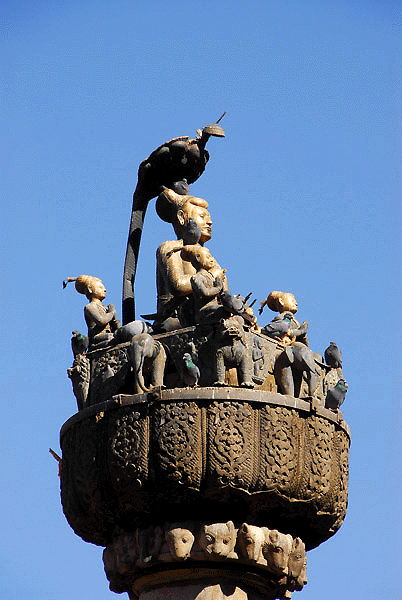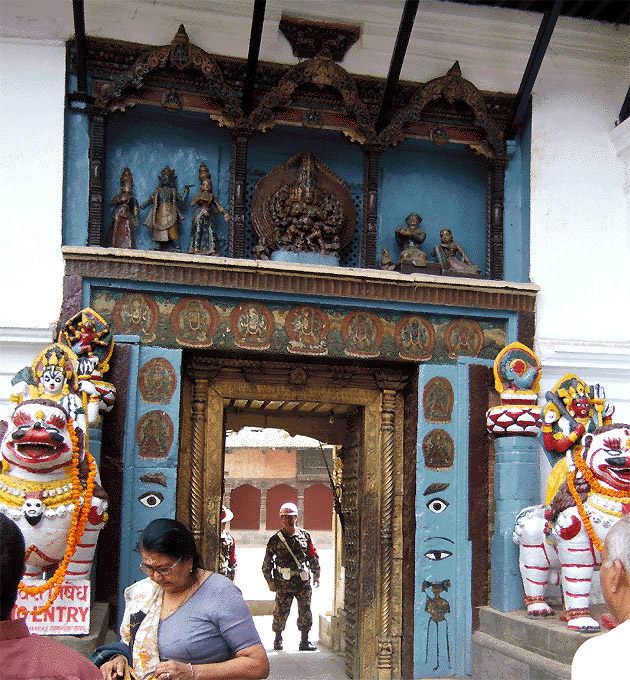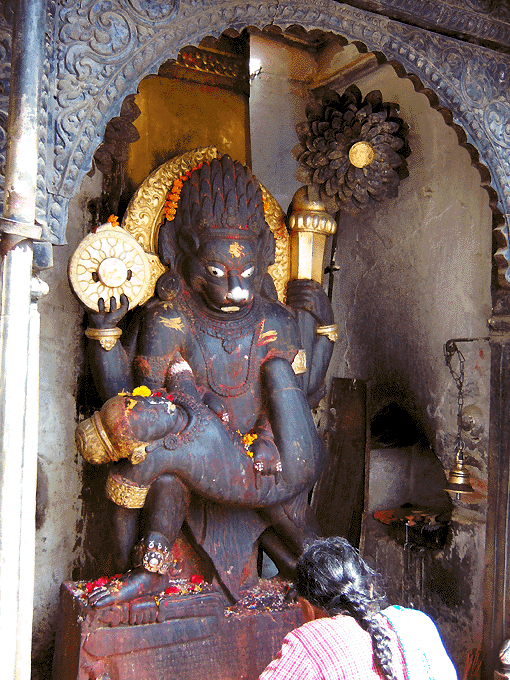Nepal in the Mahabharata Period, Part 37
BY: SUN STAFF - 10.12 2018

Pratap Malla, playing a lute, with his queen above the Hanuman Dhoka gate
The Yadava dynasty's presence in Nepal, and the events that preceded and followed.
Although our series has been focused on the broad expanse of time framing the Mahabharata Period, the history of development of Nepal's civilization can be traced much further back, through the four yugas. King Manu, the first King of Earth ruled Nepal in the Age of Truth (Satya-yuga), when it was known as the 'land of truth' - Satyawati. During Treta-yuga, the Silver Age, this place was known as Tapovan, the 'land of solitary meditation and penance'. Likewise, in the Dvapara-yuga, or Copper Age, it was known as the 'ladder of salvation', or Muktisopan. Now, in the Kali-yuga, the present age of science and technology, it is known as Nepal.
At this point in the story, we will come quite current in Nepal's Kali-yuga history, with the presence of the Malla rulers. By their names, we can see the strong Vaisnava influence that ran through the line of Malla kings. Here are a few examples:
King Shiva Simha (1609 - 1620 A.D.)
Siddhi Narasimha (1620 - 1661)
King Pratap Malla (1624-1674 A.D.)
Srinivasa Malla (1661 - 1685)
Yoga Narendra Malla (1685–1705)
Indra Malla (Purandara Malla) (1706–1709)
Vira Narasimha Malla (1709)
Riddhi Narasimha (1715–1717)
Yoga Prakash Malla (1722–1729)
Vishnu Malla (1729–1745)
Tej Narasimha Malla (1765–1768)
King Pratap Malla (1624-1674 A.D.) was the ninth king of Kantipur (Kathmandu City) and representative of the Malla dynasty of Nepal. Nepal had already been divided into three kingdoms when his rule began, and he tried to unify the Kathmandu Valley by conquering Lalitpur (Patan) and Bhaktapur (Bhadagaon), but failed in his effort. He did succeed in extending and securing the borders of Kantipur, thus monopolizing trade with Tibet, and the prosperity that resulted enabled him to refurbish many existing structures, and erect new ones. In fact, King Pratap Malla was responsible for the construction of a majority of the buildings around Durbar Square during his reign, which is seen as a cultural and economic high point of the Malla dynasty.

King Pratap Malla's Column (1641-1674)
Durbar Square, Kathmandu
A statue of King Pratap Malla is found atop a column facing the royal palace in the Kathmandu durbar square.

Hanuman Dhoka Palace Gate
His image is also seen in the niche above the Hanuman Dhoka Palace Gate (shown above, with detail picture at top of page). Featured in the three niche shrines above the gate are, at center, Sri Krishna's visvarupa (Universal Form), a ferocious tantric representation imbued with Buddhist iconography. In the left niche are more traditional Vaisnava images of Sri Krsna, Radha and Gopini; and in the right niche, King Pratap Malla playing a lute, with his queen.
Given the vast history of Nepal, and the many cycles of Vedic cultural influence that ebbed and flowed across history, one might be surprised that there aren't far more archaeological ruins, standing temples and devotional artworks associated with the passing ages, dynasties, and spheres of religious influence. But a study of the challenges faced by the Malla rulers in Nepal, what to speak of all the dynasties that preceded them, shows a concentration of events in their time that resulted in the obliteration of so many temples and shrines.
In 1255 A.D., the first Malla rulers had to cope with the destruction of one-third of the population of Kathmandu Valley -- approximately 30,000 people, including King Abhaya Malla himself. All were killed when the valley suffered a direct earthquake hit, with the epicenter right below the city.
Less than 100 years later, a devastating Muslim invasion led by Sultan Shams-ud-din of Bengal in 1345 A.D. saw the destruction of countless Hindu and Buddhist temples and monuments over the course of a looting and burning spree. Fortunately, the invasion did not leave a lasting cultural effect like in the Kashmir Valley, which remains Muslim to this day. In India the damage perpetrated by the Mughal Islamists was more widespread, and many Hindus were driven into the hills and mountains of Nepal, where many small Rajput principalities sprung up.
In fact, almost none of the existing buildings in Kathmandu Valley date from before this raid. Although in the case of some of the rebuilt temples, there are inscriptions and other information indicating the date the original structures were built or the deities installed, little else remains. The only temple in Kathmandu Valley that escaped destruction at the hand of Sultan Shams-ud-din was the Changu Narayan Temple, which escaped notice, lying several hills away from Kathmandu City.
Among the religious shrines that were built and installed following this period of destruction are the Deity statues poised at the gates of each Darbar Square, in Kathmandu City, Lalitpur and Bhaktapur. Lord Narasimhadeva has a great place of honor in all three royal squares, beginning with the beautiful Narasimhadeva situated at the entrance to Hanuman Dhoka Palace.

Lord Nrsimhadeva at Hanuman Dhoka
Lord Narasimha was installed at Hanuman Dhoka by King Pratap Malla in 1673 A.D. An inscription at the bottom of the statue states that the King had the Deity made and installed in order to ask forgiveness for daring to impersonate Vishnu in a dance-drama. A small image of King Pratap Malla can be seen next to the inscription.

Lord Narasimha killing Hiranyakasipu
Hanuman Dhoka Palace Gate






































